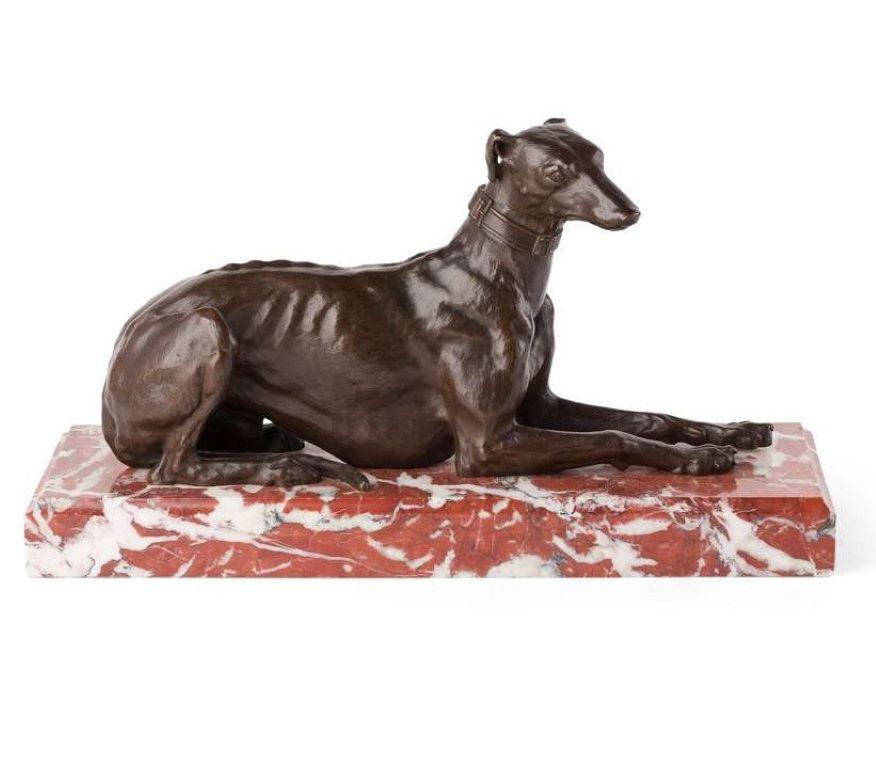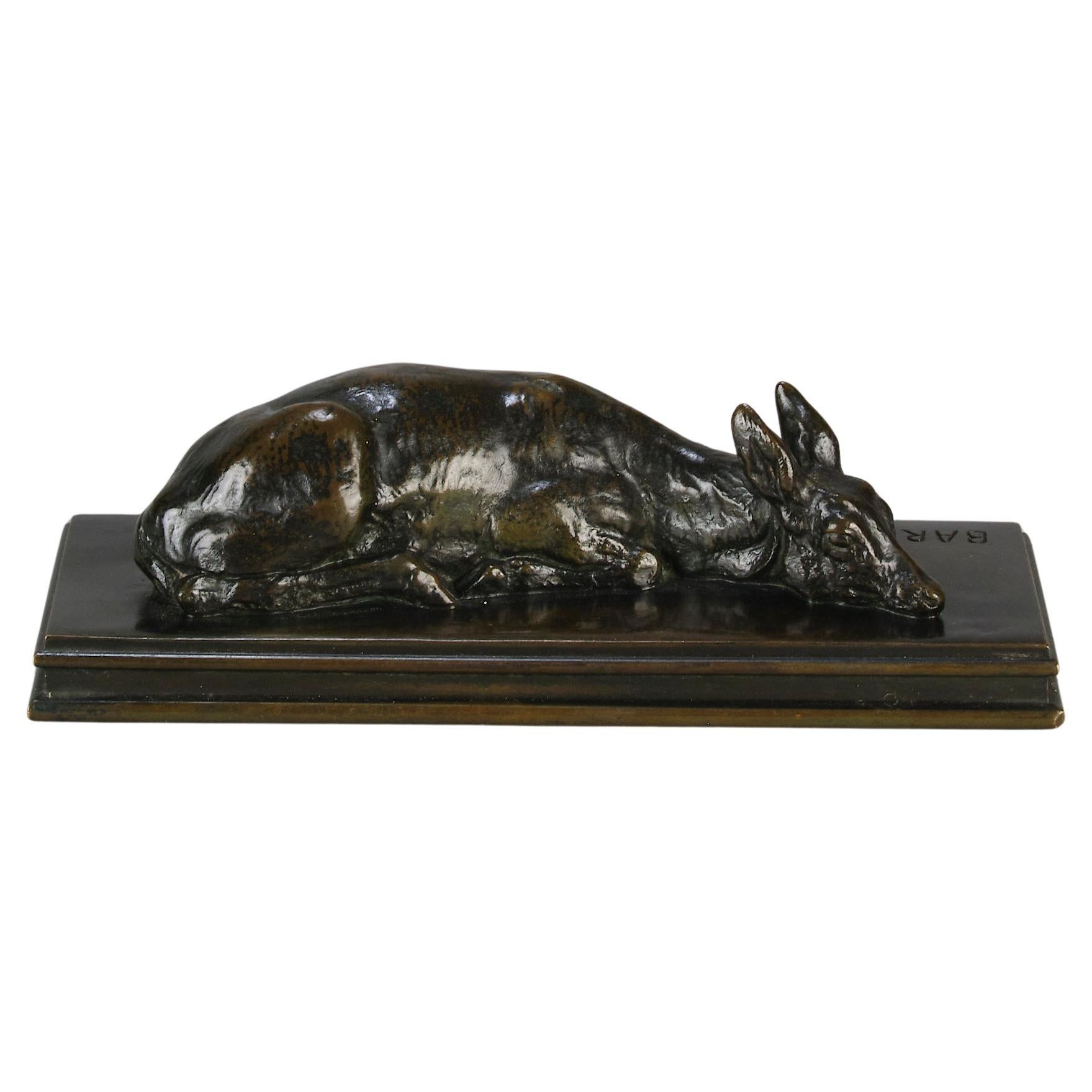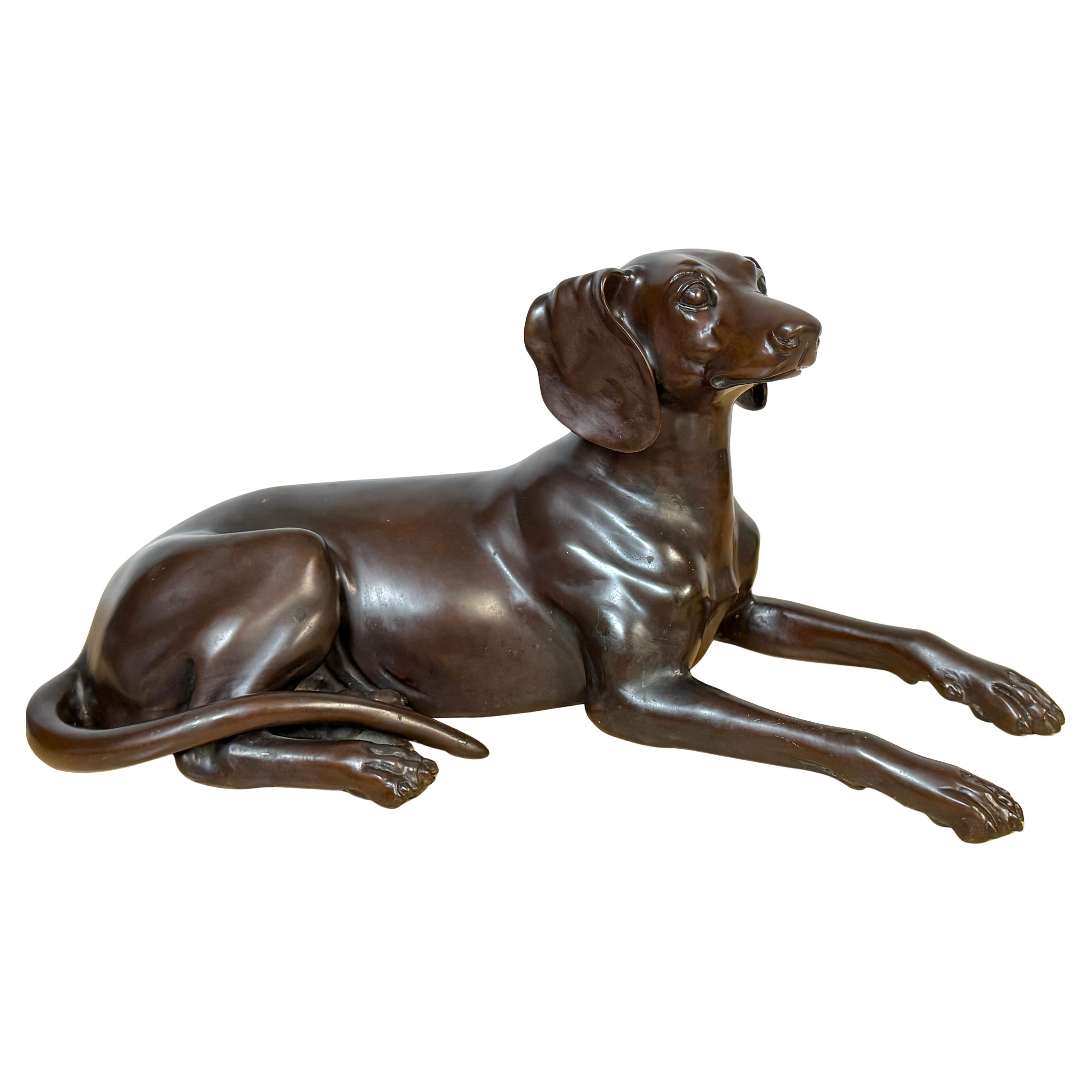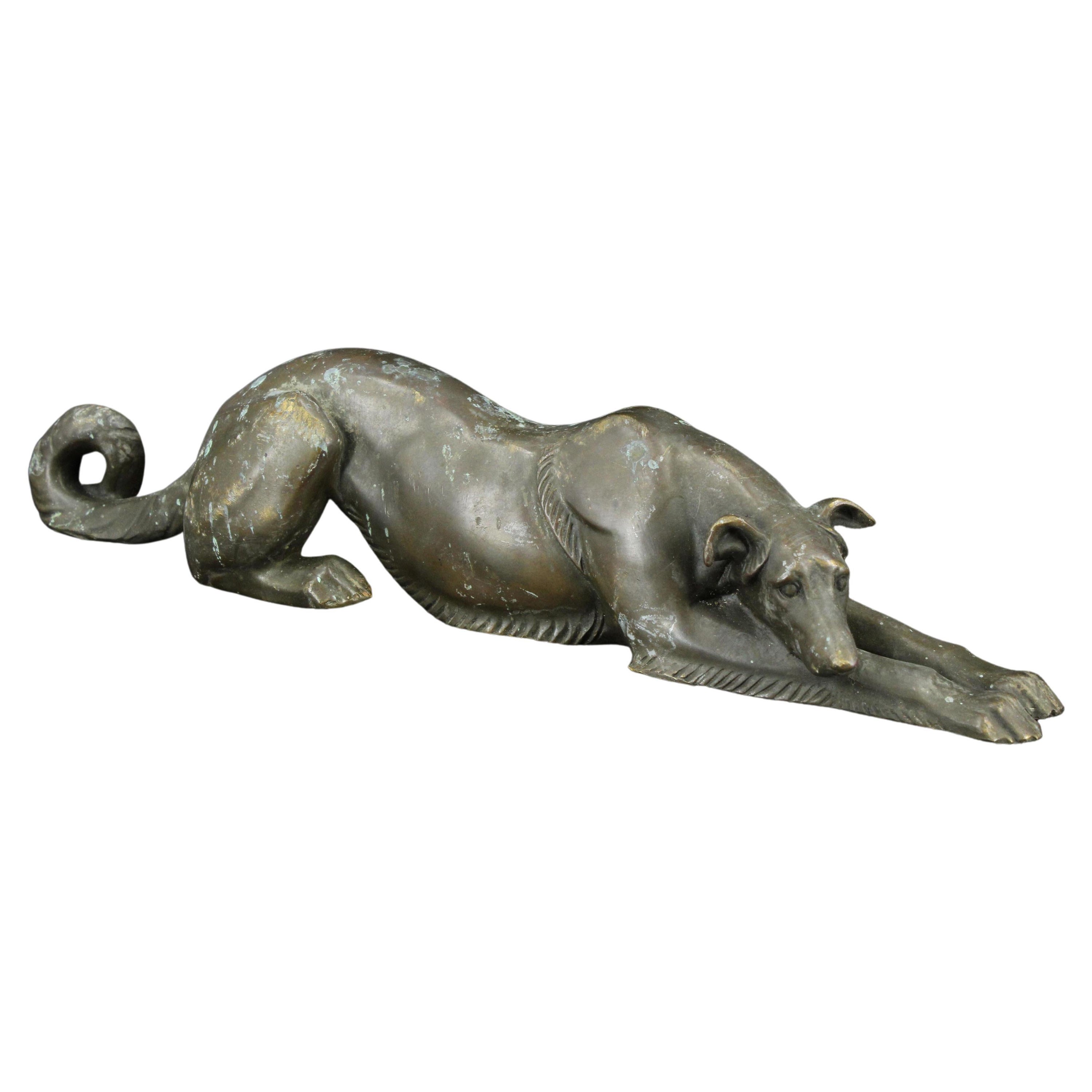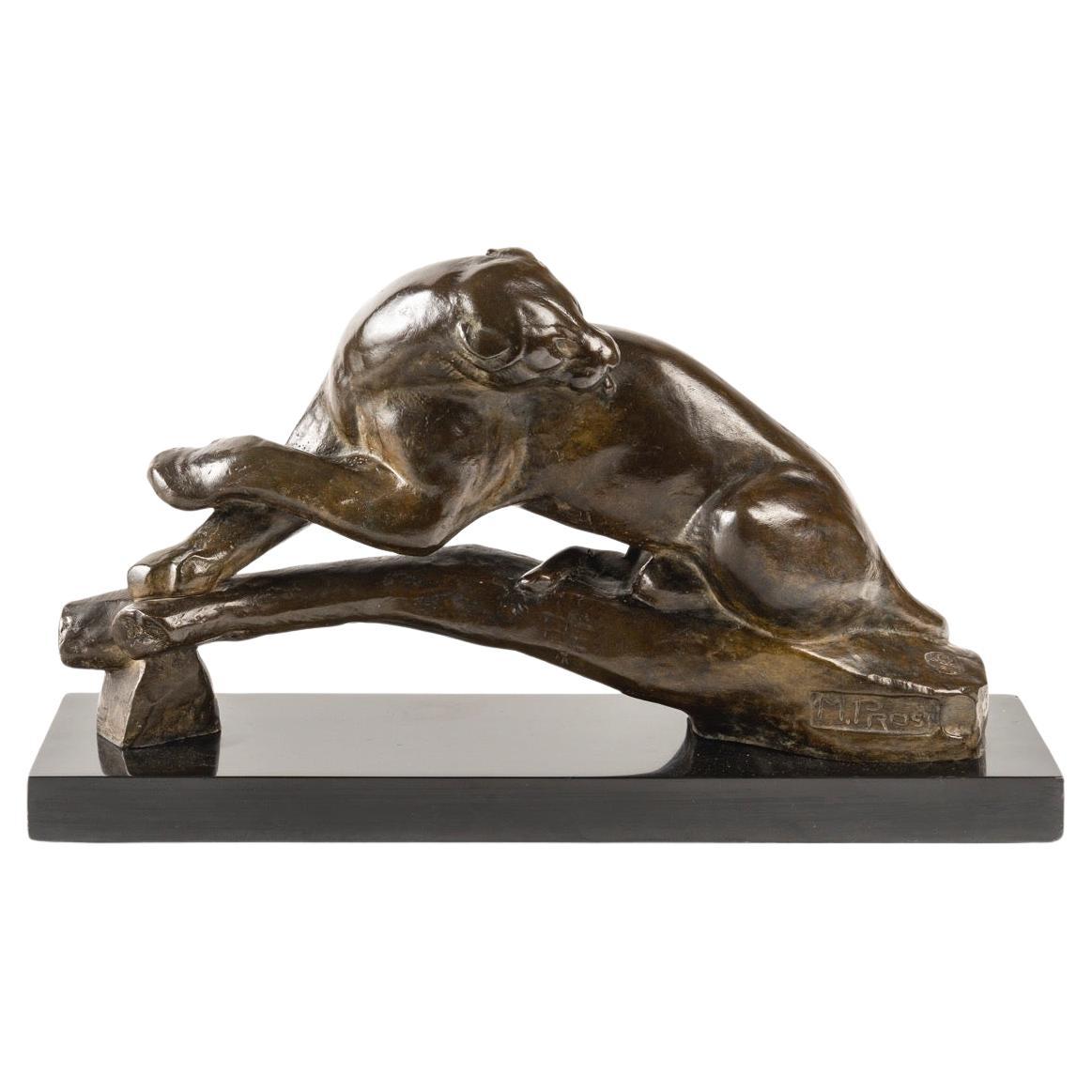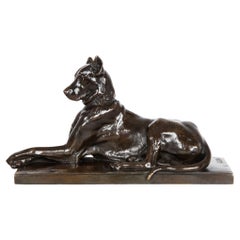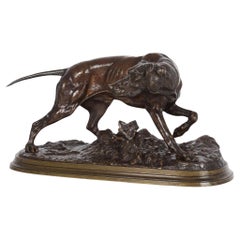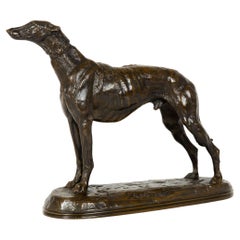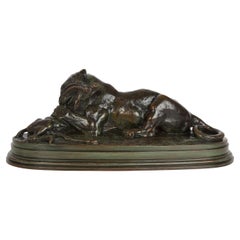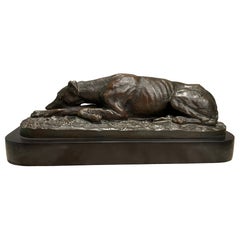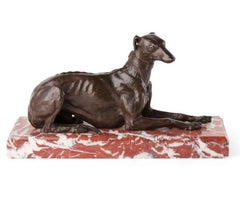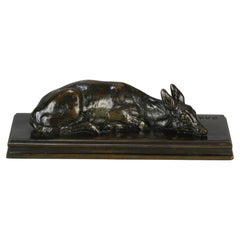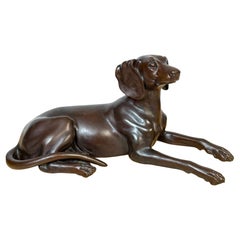Items Similar to French Bronze Sculpture "Reclining Greyhound" by Christophe Fratin, circa 1860
Video Loading
Want more images or videos?
Request additional images or videos from the seller
1 of 15
French Bronze Sculpture "Reclining Greyhound" by Christophe Fratin, circa 1860
$3,900
£2,947.92
€3,387.68
CA$5,430.73
A$6,041.46
CHF 3,167.01
MX$73,825.17
NOK 40,327.91
SEK 37,963.15
DKK 25,287.75
Shipping
Retrieving quote...The 1stDibs Promise:
Authenticity Guarantee,
Money-Back Guarantee,
24-Hour Cancellation
About the Item
An exquisite sand-cast model of Levrier Couché cast circa 1860, the sculpture is typical of Fratin's vivid texturing and silky finish. It was executed in the foundry of Alfred Daubrée with his cold-stamped atelier marking along the base edge. The underside is marked in ink "845". A superior and incredibly rare model. Christophe Fratin Christophe Fratin was one of the earliest sculptors to exclusively depict animals as the central theme of his work, a subject matter that would eventually become known as the Animalier school. His sculpture is perhaps best characterized as being technically and anatomically exact while his ability to work creatively in the surface defined his oeuvre and makes his work immediately recognizable. Where the eye of his patrons had been trained by academic models of the 18th and 19th century to expect crisp chiseling, perfect surfaces and sinuous lines, Fratin departed from the norm with an impressionistic surface that sought to convey movement in these static objects. Almost model put forth by Fratin starts with motion and the movement of the body. Surprisingly little is known about the life of Christophe Fratin. Most modern references note his birth in 1801, while older reference documents record his birth year as 1800 in Metz, France. His father was a naturalist and a taxidermist, a profession Fratin apprenticed in under his father until 1821. The early influence of his father's profession would impact Fratin's art throughout his life. A criticism of his early work that perhaps arose from this influence is the rigid modeling in his poses, almost as if the animal were being stuffed on his father's work-bench. Initially studying under Charles Augustin Pioche (French, 1762-1839), a local sculptor who had returned to Metz after a successful career, Fratin was frustrated by the senility of his tutor and moved to Paris. Here he worked in the studio of celebrated painter and sculptor Théodore Géricault, an adventurous artist with vision from whom he gained his lifelong affinity for equestrian subjects as well as his loose surface touch, likened in many ways to the heavy handed impasto of a loose paint brush in the hands of his teacher. He exhibited at the Paris Salon from 1831 to 1842, with numerous models being recorded by Lami as being rejected towards the end of this period. Taking a break from exhibiting at Salon until after the Revolution, he began submitting work again from 1850 through 1862. The citation with his awarded medal during London's Great Exhibition of 1851 noted him as being the greatest animal sculptor of his day. Unlike his contemporaries, Antoine-Louise Barye and Pierre Jules Mene, Christophe Fratin had no foundry of his own and relied on the services of Parisian foundries to cast his work for him. These he executed both in terra-cotta and bronze, though much of his terra-cotta work has not survived to the present. He is recorded as having terra-cotta models cast by Susse Freres as early as the 1830s. He funded at his own expense and also largely supervised the casting of a larger portion of his models by Quesnel through 1847, these being almost without exception of exquisite quality. Models were also cast later in his life by the houses of Thiebaut Freres, Daubré, Richard, Eck and Durand as well as Debraux D'Anglure. While Fratin had great success in his own country, his equestrian models were incredibly popular with patrons in England and he received commissions from Austria, Germany and America. One of his best known commissions was for New York City, a bronze group of two eagles standing guard over their prey, a fallen ram. It is the oldest sculpture in Central Park, completed by Fratin in 1850 and installed in 1863. Fratin died at Raincy in Seine-et-Oise in August of 1864. His equestrian models are largely regarded as some of his best works, but the series of bears engaged in human-like activities are highly sought-after by collectors - these are notably anthropomorphic, perhaps poking fun at the excesses of such emotional expression in his Romantic contemporaries in their depictions of animal subjects. Alfred Daubrée (French, 1810-1885) Perhaps best known for his work in silver, Daubrée was both an editeur and fabricant of bronzes and worked out of a shop at 21 rue St-Dizier, Nancy until around 1852 when he moved to Paris. There he opened a shop at 85, rue Montmartre and in 1855 he opened an atelier for art bronzes. He was well-regarded for the quality of his output and started executing bronzes for Antoine-Louis Barye in 1850, later handling works for Charles Cumberworth, Léopold Kamf, and Louis Menessier as well as many works for Christphe Fratin. Reinis notes that Fratin's work was sometimes marked DAUBRÉE and A. DAUBRÉE EDITEUR, though these markings were rarely applied to Barye's bronzes. Artist listings & bibliography: The Founders and Editors of the Barye Bronzes, J.G. Reinis, 2007, p. 84 (discussion of Alfred Daubrée) E. Benezit Dictionary of Artists, Vol. V, Gründ, 2006, p. 1044 Bronzes of the Nineteenth Century: A Dictionary of Sculptors, Pierre Kjellberg, p. 322-27 The Animaliers, James Mackay, p. 61-65, p. 146-47 The Bronzes of "Les Animaliers", Jane Horswell, p. 81 Art Bronze, Michael Forrest, p. 475 Animals in Bronze, Christopher Payne, 2002, p. 404 Dictionnaire des Sculpteurs de L'École Française, Vol. II, Stanislas Lami, p. 403-405 Measurements: 9 3/4" W x 3 3/8" D x 2 1/2" H.
- Creator:Christophe Fratin 1 (Sculptor)
- Dimensions:Height: 2.5 in (6.35 cm)Width: 9.75 in (24.77 cm)Depth: 3.37 in (8.56 cm)
- Style:Romantic (Of the Period)
- Materials and Techniques:
- Place of Origin:
- Period:
- Date of Manufacture:Unknown
- Condition:Wear consistent with age and use. Excellent original condition, no flaws.
- Seller Location:Shippensburg, PA
- Reference Number:Seller: 102EWL26Q1stDibs: LU1059022977872
About the Seller
4.9
Recognized Seller
These prestigious sellers are industry leaders and represent the highest echelon for item quality and design.
Platinum Seller
Premium sellers with a 4.7+ rating and 24-hour response times
Established in 2009
1stDibs seller since 2014
511 sales on 1stDibs
Typical response time: 1 hour
- ShippingRetrieving quote...Shipping from: Shippensburg, PA
- Return Policy
Authenticity Guarantee
In the unlikely event there’s an issue with an item’s authenticity, contact us within 1 year for a full refund. DetailsMoney-Back Guarantee
If your item is not as described, is damaged in transit, or does not arrive, contact us within 7 days for a full refund. Details24-Hour Cancellation
You have a 24-hour grace period in which to reconsider your purchase, with no questions asked.Vetted Professional Sellers
Our world-class sellers must adhere to strict standards for service and quality, maintaining the integrity of our listings.Price-Match Guarantee
If you find that a seller listed the same item for a lower price elsewhere, we’ll match it.Trusted Global Delivery
Our best-in-class carrier network provides specialized shipping options worldwide, including custom delivery.More From This Seller
View AllFrench Antique Bronze Sculpture “Great Dane” by Georges Gardet
By George Gardet
Located in Shippensburg, PA
GEORGES GARDET
French, 1863-1939
Recumbent Great Dane
Patinated bronze signed in cast "G. GARDET", cold-stamped "865 K" and "FRANCE"
Item # 311KOG07P
A good casting of Gardet's Rec...
Category
20th Century French Romantic Animal Sculptures
Materials
Bronze
French Antique Bronze Sculpture of Pointer Dog by Pierre-Jules Mêne circa 1880
By Pierre Jules Mêne
Located in Shippensburg, PA
PIERRE-JULES MÊNE
French, 1810-1879
"Chien braque à la feuille"
Medium-brown patinated sand-cast bronze raised edge signature cast into base "P.J. MÊNE" ...
Category
Antique 19th Century French Romantic Animal Sculptures
Materials
Bronze
French Antique Bronze Sculpture “Standing Greyhound” by Emmanuel Fremiet
By Emmanuel Fremiet
Located in Shippensburg, PA
EMMANUEL FREMIET
French, 1824-1910
"Chien Levrier"
Patinated bronze signed E. Fremiet in naturalistic base cold-stamped 85, a Charles More cast
Item # 411PRB18X
An exquisite mo...
Category
Antique 19th Century French Romantic Animal Sculptures
Materials
Bronze
French Antique Bronze Sculpture "Tiger Devouring Gazelle" by Antoine-Louis Barye
By Antoine-Louis Barye, F. Barbedienne Foundry
Located in Shippensburg, PA
ANTOINE-LOUIS BARYE
French, 1795-1875
"Tigre Dévorant une Gazelle (second edition)"
Verde and autumnal patinated bronze Signed in cast "BARYE", incised "F. Barbedienne Fondeur" c...
Category
Antique 19th Century French Romantic Animal Sculptures
Materials
Bronze
French Antique Bronze Sculpture of Tigress at Rest by Paul Edouard Delabrierre
By Paul Edouard Delabriere
Located in Shippensburg, PA
A very good sand cast example of a Tigress at Rest after the model by Paul Edouard Delabrierre, it is a sensitive and precious glimpse of the ...
Category
20th Century French Romantic Animal Sculptures
Materials
Bronze
Bronze Sculpture "Panther of Tunisia" After Antoine-Louis Barye, Barbedienne
By F. Barbedienne Foundry, Antoine-Louis Barye
Located in Shippensburg, PA
An exceedingly fine posthumous cast of Barye's Panther of Tunisia no. 2 executed by the foundry of Ferdinand Barbedienne, this piece retains it's silky original overall nearly transl...
Category
Antique 19th Century French Romantic Animal Sculptures
Materials
Bronze
You May Also Like
19th Century French Bronze Reclining Greyhound by Christopher Fratin, 1801-1864
By Christophe Fratin
Located in Stamford, CT
Very sensitive rendering of a greyhound at rest with a rich dark brown patina with lighter highlights showing through. The dog is shown reclining with one paw turned up, a detail I find endearing as a dog owner, my border collie does this too! Mounted on a polished black slate base, marked Fratin on the base. Also stamped with the foundry mark 'Daubree, Editeur'.
A fine desk top, shelf, or mantel piece for the dog lover,
Christopher Fratin (1 January 1801 – 16 August 1864), also known as Christophe Fratin, was a noted French sculptor in the animalier style, and one of the earliest French sculptors to portray animals in bronze.
Fratin was born in Metz, Moselle, France the son of a taxidermist. He first studied drawing under Pioche in Metz and later worked in Paris at the studio of Théodore Géricault.
He exhibited at the Paris Salon from 1831 to 1842 and 1850–1862, as well as at the Great Exhibition in London in 1851. Fratin never signed his bronzes but instead used a stamp showing his last name in straight block letters.
Fratin received monumental commissions in France and elsewhere, including the Deux Aigles Gardant Leur Proie (Eagles and Prey, created 1850) displayed since 1863 in New York City’s Central Park. Today, Fratin’s sculpture is on permanent display in the Louvre, the city museums of Metz, Lyon, Strasbourg, Nîmes and at the Peabody Institute in Baltimore, Maryland. The Georg Eisler...
Category
Antique Mid-19th Century French Barbizon School Animal Sculptures
Materials
Slate, Bronze
A large late 19th century French animalier bronze of a recumbent greyhound dog
By Christophe Fratin
Located in Bath, Somerset
A large late 19th century bronze figure of a recumbent greyhound after French animalier sculptor Christophe Fratin (1801-1864), with a warm brown patina on a rouge griotte marble base. Signed 'FRATIN' on collar.
Bronze length: 37cm
Base length: 41cm
Bronze height: 18cm
Total height: 22cm
Christophe Fratin was born in Metz in France in 1801. He first studied sculpture under Pioche in Metz under whom he honed his technical skills. He then became a pupil of the painter Theodore Gericault in Paris where he pursued his career as a sculptor.
Fratin first exhibited at the Paris Salon as early as 1831, where he showed ‘Fermer – An English Thoroughbred’. The popularity of Fratin’s sculpture in England had a significant impact on his career. His modelling style reflected his imaginative mind and sense of humour, particularly in his humorous modelling of bears.
Fratin was asked to sculpt life-size monuments for French cities, including his home town of Metz. At the Great Exhibition of 1851 in London he was considered the greatest animalier sculptor of the day. Fratin’s bronzes...
Category
1880s Naturalistic Figurative Sculptures
Materials
Bronze
Mid 19th Century Animalier Bronze Study entitled "Reclining Doe" by A L Barye
By Antoine-Louis Barye
Located in London, GB
An endearing late 19th Century Animalier bronze study of a reclining doe with excellent rich brown, black and green patina and very fine hand chased surface detail. Raised on an inte...
Category
Antique Mid-19th Century French Art Nouveau Animal Sculptures
Materials
Bronze
French School Patinated Bronze of Recumbent Hunting Dog
Located in West Palm Beach, FL
French School Patinated Bronze Sculpture of a Recumbent Hunting Dog
French School, 20th Century
A beautifully cast 20th-century French School bronze sculpture of a resting hunting dog, exhibiting remarkable realism and expert artistry. This work is finely cast in bronze with a rich brown patina, emphasizing the lifelike musculature, gentle expression, and elegant posture of the dog.
This striking sculpture measures 10 inches high, 23 inches wide, and 8.5 inches deep, making it a substantial yet graceful presence in any collection or display setting. The artist has captured the natural repose of a loyal hunting companion, with detailed attention to the anatomy, coat texture, and alert yet relaxed demeanor.
A superb addition to any classical, sporting, or fine art collection, this bronze is ideal for dog lovers, collectors of French animalier sculpture...
Category
20th Century French Sporting Art Animal Sculptures
Materials
Bronze
Early 20th Century, Bronze Greyhound Sculpture by Louis Albert Carvin
Located in Middleburg, VA
Louis Albert Carvin bronze sculpture of Greyhound laying down.
Impressed "Carvin"
Measures: 2.5" H, 11.75" W, 2.75" D.
Category
Early 20th Century French Animal Sculptures
Materials
Bronze
Maurice PROST (1894 - 1967) Panthère au repos , An Art Deco Bronze Sculpture
By Maurice Prost
Located in Saint-Ouen, FR
Maurice PROST (1894 - 1967)
"Panthère au repos"
Bronze Sculpture with a nuanced brown patina
Resting on a rectangular black marble base
Signed M. Prost and sculptor’stamp with 2 cobras, numbered 2.
Old edition font.
Only three specimens known in this dimension
Maurice Gaston Elie Joseph Prost (1894-1967) studied with the sculptor Léopold Morice...
Category
Vintage 1930s French Art Deco Animal Sculptures
Materials
Belgian Black Marble, Bronze
More Ways To Browse
Antique Sculptures London
Antique French Documents
Very Large Bronze Sculpture
Recline Sculpture
Recliner 19th Century
Animalier Sculpture Bronze
French Animalier Sculpture
1850 Bronze Sculpture
Antique French Dictionary
German Antique Bronze Sculptures
Reclining Bronze
Greyhound Sculpture
Barye Bronze
Gold Eagle Sculpture
Barye Bronze Sculptures
Equestrian Sculptures
Bronze Mortar
American Eagle Sculptures

